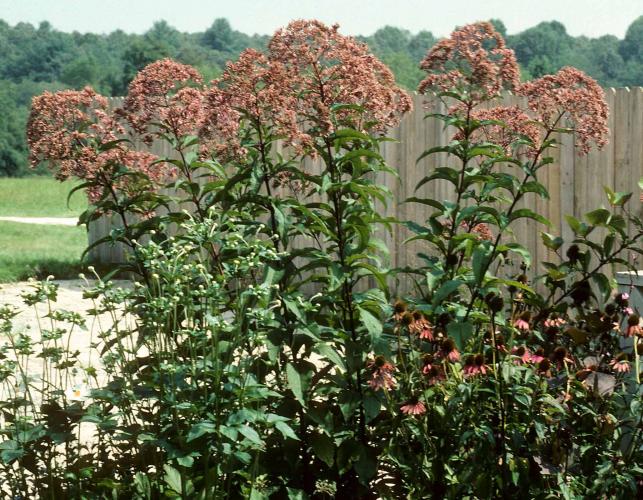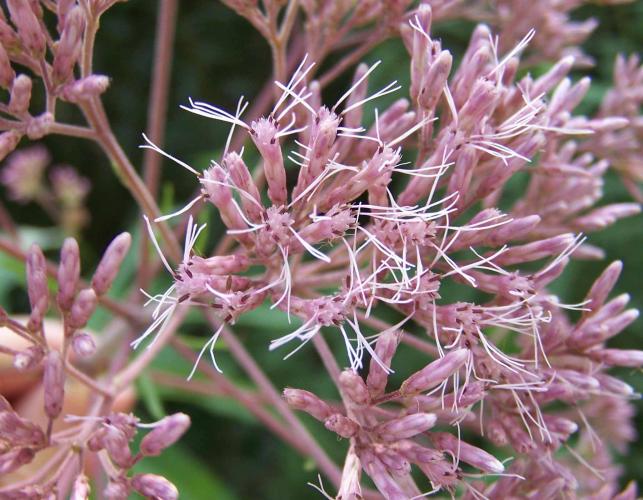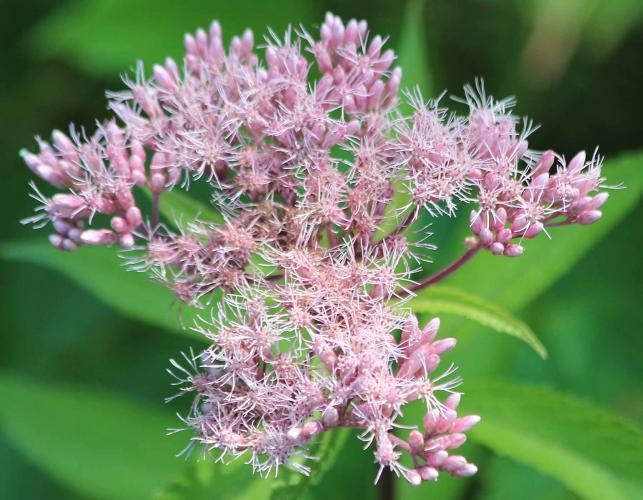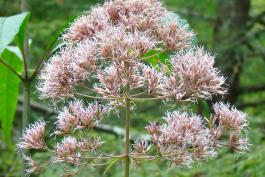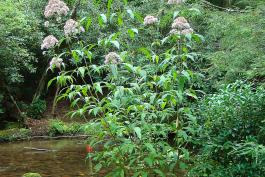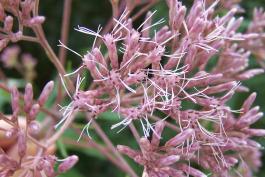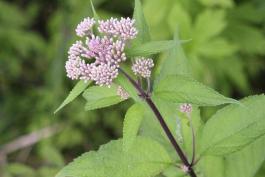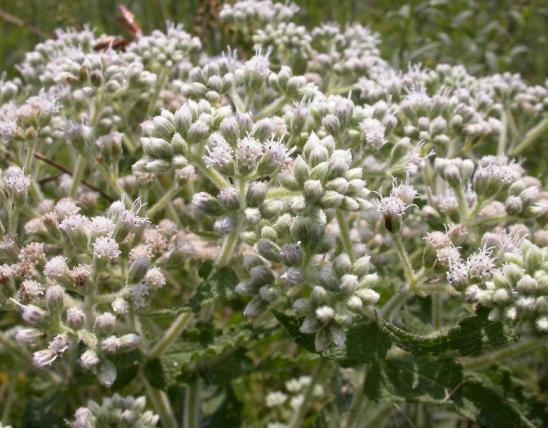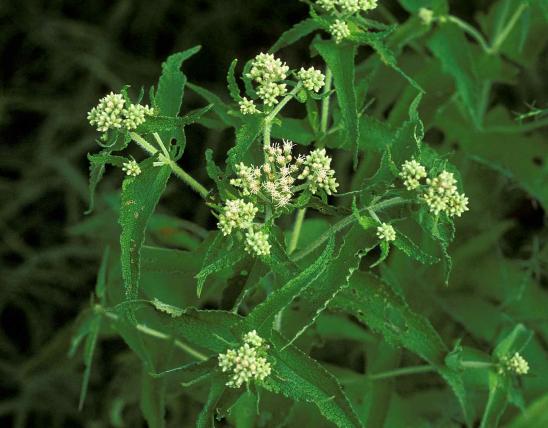
Joe-Pye weeds have rounded clusters of pink or purplish flowers and leaves arranged in whorls on the stem. These typically tall, robust plants occur in lowlands along streams.
Three species of Joe-Pye weeds have been recorded for Missouri. Until about 2000, they were placed in the same genus as the thoroughworts (or bonesets, Eupatorium), but DNA evidence convinced botanists they were different enough to have their own genus, Eutrochium (yoo-TRO-kee-um). With their pinkish or purplish-tinged flowers and leaves arranged in whorls of 3–7 on the stem, they have always been easy to separate from the white-flowering, opposite-leaved thoroughworts.
Other identifying characters include their erect growth habit; sharply toothed leaves to 8 or even 12 inches long, and the flowerheads, which have disk florets but no petal-like ray florets. The thin, threadlike styles usually protrude, giving the flowers a furry appearance from a distance. When the flowers are mature, the fruits (achenes) are topped with numerous thin hairlike bristles, making the flowerheads look even fuzzier (the fruits are similar to those of dandelions, but without the thin stalk separating the “seed” from the “parachute”). All our species bloom July–September.
Missouri’s Joe-Pye weeds include:
Green-stemmed Joe-Pye weed (or sweet Joe-Pye weed, E. purpureum) is by far the most common of the three in our state, scattered statewide, but more abundant south of the Missouri River. Occurs in bottomland forests, moist upland forests, banks of streams and rivers, roadsides, and similar habitats. Stems are dark purplish only at the nodes and are not particularly glaucous (whitish-coated); stems are rarely hollow (if so, only at the base of the stem). Flower clusters are dome-shaped; each small flowerhead has usually 4–7 florets. Leaves usually 3 or 4 per whorl.
- There are two varieties of this species in our state. Of the two, variety purpureum is more widespread; on the undersides of the leaves, it is only sparsely hairy along the main veins. Variety holzingeri is uncommon and sporadic in our state; the undersurface of the leaves is densely and evenly short-hairy.
Hollow-stemmed Joe-Pye weed (E. fistulosum) is uncommon, mostly in the eastern half of the state, especially in the Bootheel lowlands. Occurs in bottomland forests, moist upland forests, swamps, banks of streams and rivers, roadsides, and similar habitats. Stems are usually evenly dark purple, with a glaucous (whitish waxy) coating; stems are hollow (though they might be solid at the top of the plant). Flower clusters are dome-shaped; each small flowerhead has usually 4–7 florets. Leaves 4–7 per whorl.
Spotted Joe-Pye weed (E. maculatum var. bruneri) is uncommon, recorded from fens and edges of marshes in Clark and Lafayette counties. Stems usually are mottled with dark purple (or are uniformly purple) and are at most only slightly glaucous; stems are usually solid. Flower clusters are usually flat-topped; each small flowerhead has 8–22 florets. Leaves usually 4 or 5 per whorl.
Similar species: Although the thoroughworts (Eupatorium spp.) are closely related, they can easily be separated from Joe-Pye weeds by their white (not pink or purplish) flowers and by their mostly opposite (not whorled) leaves. Missouri has some other relatives with similar-looking pink, purple, or blue flowers:
- Pink thoroughwort (Fleischmannia incarnata) occurs mostly in the Bootheel lowlands, where it’s uncommon in swamps, ditches, and other moist places. It often reclines on nearby vegetation, has leaves opposite, triangular or heart-shaped, moderately tapering, with scalloped margins, and bears purple or lavender-blue flowers.
- Mist flower (blue boneset or wild ageratum, Conoclinum coelastinum), a perennial with fluffy-looking pale purple flowers, scattered mostly in the southern half of Missouri.
- The nonnative Ageratum conyzoides is a blue-flowering plant from Central and South America that has been introduced widely in tropical parts of the world. It has been collected growing outside of cultivation in Missouri once, in Marion County. It resembles mist flower but is an annual, not a perennial. It is very similar to Ageratum houstonianum, the familiar flossflower or bluemink that is often sold as a bedding plant at garden centers.
Height: our most common species, green-stemmed Joe-Pye weed, typically grows 3–7 feet tall (to 13 feet under cultivation). Hollow-stemmed Joe-Pye weed can be up to 10 feet tall.
Statewide. Different species have different distributions within the state.
Habitat and Conservation
The specific habitat preferences for our three species are included in their individual descriptions above. Generally, Joe-Pye weeds like moist bottomland habitats, often near water or wetlands, preferring open areas or woodland borders, without dense shade. These are typically tall, robust plants that occur in lowlands along streams.
Status
Spotted Joe-Pye weed (E. maculatum var. bruneri) is a species of conservation concern in Missouri, ranked as critically imperiled.
In addition to their longtime former membership in genus Eupatorium, Joe-Pye weeds were, for a while, called genus Eupatoriadelphus, so don’t be surprised if you find them listed under that name as well.
Human Connections
Green-stemmed Joe-Pye weed can be grown as a showy, fragrant native ornamental plant in landscapes and in rain gardens. It prefers moist, rich soils and is easy to grow. In cultivation, it typically grows to 7 feet and sometimes more than 13 feet tall. The large, mauve-pink, fragrant flower clusters bloom from the middle of summer into the fall, attracting butterflies and other pollinators. Grown in a group and given plenty of space, these native wildflowers really make a statement.
In the past, Joe-Pye weed had several medicinal uses among Native Americans, for treating kidney stones and other kidney and urinary ailments as well as fevers, including typhus, and as a general tonic. The medicinal qualities no doubt are what make it distasteful to deer.
Joe Pye, to the best of anyone’s knowledge, was a Mohican leader (sachem) knowledgeable about herbal medicine. His formal name apparently was Joseph Shauquethqueat (ca. 1722–ca. 1809). In western Massachusetts, in the 1700s and early 1800s, he became associated with these plants, possibly for using them to treat fevers. Apparently European Americans in New England used it to treat an outbreak of typhus. Over the years, much has been assumed about Joe Pye and his “weed,” though little is known for sure. For details on this story, read the research paper by R.B. Pearce and J.S. Pringle in Great Lakes Botanist 56 (2017): 177–200.
The genus name, Eutrochium, was originally given to the Joe-Pye weeds by Constantine Samuel Rafinesque (1783–1840), who botanized in the United States in the 1800s. He was an interesting, brilliant character worth learning about. Other botanists rejected his idea of Joe-Pye weeds as separate from the eupatoriums, so Rafinesque’s name didn’t stick, and for years, Joe-Pye weeds were in genus Eupatorium. But in about 2000, when DNA evidence showed that Joe-Pye weeds deserved their own genus, botanists (using the longstanding rules for scientific names), resurrected Rafinesque’s genus name. Eutrochium means “well-wheeled” (eu-, “well” or “truly,” plus troch, “a wheel”); this refers to the whorled leaves characteristic of this group of plants.
Ecosystem Connections
Like goldenrods, ironweeds, native asters, and many other composites that produce big clusters of flowers late in the season, Joe-Pye weeds attract a wide array of pollinators — butterflies, bees, wasps, flies, beetles, and more. The presence of these insects makes them a hunting ground for many kinds of spiders, assassin bugs, robber flies, and other predators. Insect-eating birds also keep watch on the flower clusters.
Caterpillars of several moth species have been recorded feeding on Joe-Pye weed foliage, including the three-lined flower moth (Schinia trifascia), a noctuid that also feeds on other members of the same aster-family tribe as Joe-Pye weeds, including thoroughworts (Eupatorium), brickell bushes (Brickellia), and blazing stars (Liatris). Another is the common eupithecia (Eupithecia miserulata), a nondescript geometrid moth whose larvae mimic twigs by resting rigidly at an angle to the surface of the plant.
Many other insects feed on Joe-Pye weeds, sucking sap, chewing leaves and flowers, and boring into the stems, roots, and leaves: aphids, treehoppers, leaf beetles, leaf miner flies, and more. These and other herbivores are important foods for birds (especially during nesting season) and other insectivores.
Joe-Pye weeds apparently are not very palatable to deer and other grazing mammals.
The root systems of Joe-Pye weeds and other bottomland and streamside plants play a critical role in preventing erosion during floods and other high-water events. By keeping soil from washing away into streams, they help aquatic organisms survive and reproduce. They also keep rich topsoil on the land, where it benefits plants (and human agriculture). The root systems of streamside plants absorb chemicals, such as agricultural fertilizers and pesticides, preventing them from washing into streams where they would pollute the water.
Globally, there are five species of Eutrochium, and all are native to North America. The two that don’t occur in Missouri are coastal plain Joe-Pye weed (E. dubium) and Appalachian (or Steele’s) Joe-Pye weed (E. steelei).




